The 1980s: A Golden Era of Tennis
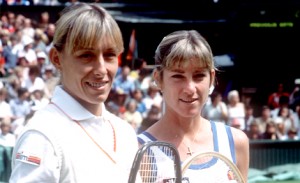
The 1980s were a Golden Era for Professional Tennis.
It was the best of times – Tennis in the Eighties – when the thrill of tense tiebreaks entered everyman’s domicile, highlighted by exotic locales like Paris, Melbourne, London and New York.
The 1980s tennis also ushered in exciting yet exasperating players whose on-court conduct thrilled, engaged and enraged fans across the globe.
The ’80s energized the popularity base and took tennis out of country clubs and landed estates and into public parks and arenas. It became a sport in contrast to an amenable pastime.
Setting the Stage
On the men’s side of the game, after years of haggling over sponsorships and professional contracts, the struggling players finally formed a union of their own that allowed them to be free agents.
At last players selected their own tournaments and guided their own destinies. Although there were some lingering entanglements, anxieties, and even resentments, male tennis players of the eighties could finally pour their energies into playing tennis, striving to win the grand slams and becoming world ranked number one!
Professional tennis for women does not have as extensive a history of controversy as the men’s game provides, but it was equally as fractious during the open era, finally resolving itself into the formation of the WTA in 1973.
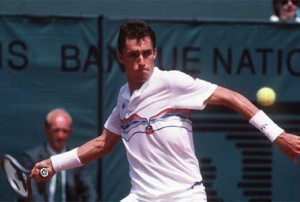
One of five men to hold the number one World ranking during the 1980s, Ivan Lendl held the number one ranking for 238 weeks during the decade.
The elimination of the division of labor between amateurs and professionals allowed the best men and women to play tennis at all of the big events. It opened the game wide up and participation soared to new heights in the ’80s.
The bigger the names, the bigger the games and even more to the point, the larger the demand – televised coverage of the grand slams became a staple and not just the finals but extended coverage of matches leading up to the finals.
It was a perfect storm of exposure, enthusiasm and artistry because the 80s opened up the floodgates and just look at who came pouring through…
The Men
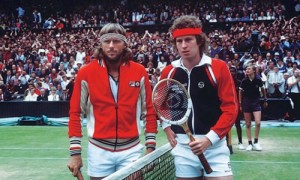
Bjorn Borg and John McEnroe opened the decade with a classic Wimbledon final.
The number one ranked men’s player in 1980 was Bjorn Borg who had been playing tennis since the age of 14. Renowned for stunning good looks, long blond hair and mythical mystique – Borg alone brought hundreds of young men flocking to play the game because the Swede was a babe magnet – to use the 80s vernacular – and they aspired to follow in his footsteps.
Borg was more physically fit than the tennis players of previous generations and this factor was one of his main contributions to the men’s game in the 80s and beyond.
Borg’s main competitor was number two-ranked John McEnroe. Borg and McEnroe’s tightly contested matches drew huge crowds, record-breaking numbers of television viewers and an unending demand for more.
McEnroe’s outrageous behavior and his serve and volley game laid waste to the staid and steady traditions of the past now blasted into orbit by McEnroe and his American contemporaries. The tennis world did not quite know how they felt about the red-faced, hot-tempered but extremely talented American.
Borg won his 5th consecutive Wimbledon Championship in 1980 but lost the U.S. Open again. He won the French Open for the sixth time in 1981 but lost both Wimbledon and the U.S. Open.
Seemingly invincible, Borg burned bright then dimmed out completely in 1981, leaving the game shrouded in that same mystique that cloaked him throughout his career.
McEnroe reigned atop the tennis world in 1981, 1982, 1983, and 1984 holding the number one ranking during each of these years. After Borg’s departure, McEnroe’s main competition came from the equally explosive and volatile Jimmy Connors who had a dominating two-handed backhand, a blistering return of serve and a willingness to die before giving in.
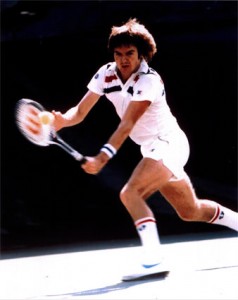
Jimmy Connors won the U.S. Open twice and Wimbledon once during the 1980s.
But there was a new brand of tennis being introduced and a new number one being groomed – Ivan Lendl of Czechoslovakia. Lendl ushered in the era of power tennis that still survives today utilizing heavy topspin and reliance on pure strength and accuracy – possible now with new racket technology.
His running forehand allowed him the choice of going down the line or cross court. In that respect, his game was comparable to Borg and like Borg the Czech was physically fit.
It took Lendl some time to grow into his game and achieve success; but once he won that first major by defeating the serve and volleyer John McEnroe at the French Open in 1984, Lendl never looked back.
Lendl was the number one player in 1985, 1986, 1987, and 1989. His only interruption came at the hand of Mats Wilander who knocked him off his perch temporarily in 1988.
Following in McEnroe’s shoes were other serve and volleyers who made their mark generally at Wimbledon, a tournament Lendl could never win or on the hard courts. Serve and volley players never fared well on red clay.
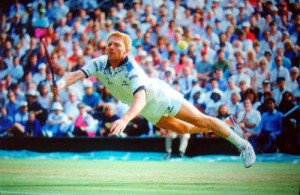
Boris Becker exploded on the scene at the 1985 Wimbledon Championships.
Boris Becker won Wimbledon at age 17 in 1985 as an unseeded player with his Boom-Boom serve, his net play and his heavy forehand. His reign at number one was measured in a few weeks – Becker always sat just behind Lendl in the rankings.
In addition to Becker was Swede Stefan Edberg ranked number one in the early 90s. Breaking into the top 10 in 1985, Edberg had the most beautiful-to-behold serve and volley game accelerated by an impeccable kick serve.
The roll call for serve and volley players who graced the grass in the 80s when their game reigned supreme extends to include Pat Cash and Henri Leconte. There were other gifted athletes like Yannick Noah whose pure athleticism set them apart.
Basically the 80s were divided by baseliners, headed by Lendl and Wilander and serve and volleyers led early by McEnroe and later by Becker and Edberg. The game was changing because equipment evolved and players were becoming more physically fit, stronger and more imposing.
On the horizon, the baseliners saw new Americans emerging – Andre Agassi and Michael Chang. The 90s would see the emergence of perhaps the best serve and volley player of all time, Pete Sampras, who had been paying attention to the fortunes of of players like Boris Becker and Stefan Edberg and thought he would give their game a whirl…
The Ladies
The ’80s – dominated by Chris Evert, Martina Navratilova and Steffi Graf saw the rise of newcomer Monica Seles blow the lid off their carefully constructed game as the ’90s rolled into view.
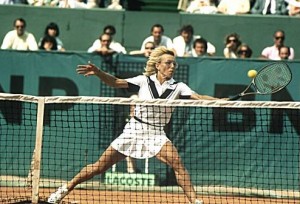
Martina Navratilova won 15 singles and 25 doubles Grand Slam titles during the 1980s.
To equate them to their male counterparts – Chris Evert dominated on clay like Borg with a carefully crafted and extremely accurate game. She was rigorously fit and quietly determined with an iron will equal to ice-man Borg’s on any given day.
Evert won 18 grand slam singles titles on all surfaces but was most proficient on clay where she won a record 125 consecutive matches on the surface. One imagines that had Borg extended his playing life, his record on clay might have equalled the “Ice Maiden’s.”
Martina Navratilova’s rise equalled John McEnroe’s with her prowess as a serve and volley player. Once Navratilova became fully fit and once she adopted a graphite racket – the former Czech player became perhaps, the greatest player in the history of the game, man or woman.
Her battles with Evert were as monumental in their way as the Borg-McEnroe matches – except the ladies matches went on for years. Navratalova dominated on grass winning nine grand slam titles at Wimbledon. Like McEnroe, Navratilova also had a superior doubles game and won 31 grand slam doubles titles.
Navratilova was the number one ranked player from 1982-1986.
Her reign at the top was interrupted when a 17 year old German named Steffi Graf appeared on the scene. Much like Ivan Lendl’s appearance, Graf’s game focused on power, countering the effectiveness of the serve and volley play. Graf had an amazing inside out forehand that became her weapon of choice as well as tremendous foot-speed.
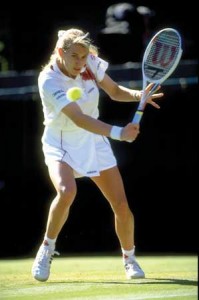
Steffi Graf replaced Martina Navratilova as the number one player in women's tennis.
Her serve, her angles and her mental strength combined to make her one of the greatest athletes ever to play the game of tennis, winning 22 grand slam singles titles – the most of any man or woman except Margaret Court who won 24.
As Graf rose to number one in 1987, 1988 and 1989, Navratalova fell to number two. Graf remained the number one ranked player for 377 consecutive weeks by the WTA, the longest of any player, man or woman, since tennis professionals began ranking players.
As the eighties began to fade, a new player from Yugoslavia named Monica Seles brought new firepower and aggression to the women’s game. Change was becoming the order of the day for the women’s game.
On the men’s side, along with Andre Agassi and Michael Chang, newcomers Jim Courier and Pete Sampras were beginning their new tennis careers aided by fantastic new technology and unlimited boundaries.
In the 80s, because of increased television coverage, new technology, exciting and controversial players and unending opportunities, tennis exploded in popularity. The era ended as serve and volley play began its inevitable death march and power tennis began to dominate…
Check back soon for a look at the 1990s.
JA Allen is a regular contributor to Sports Then and Now.
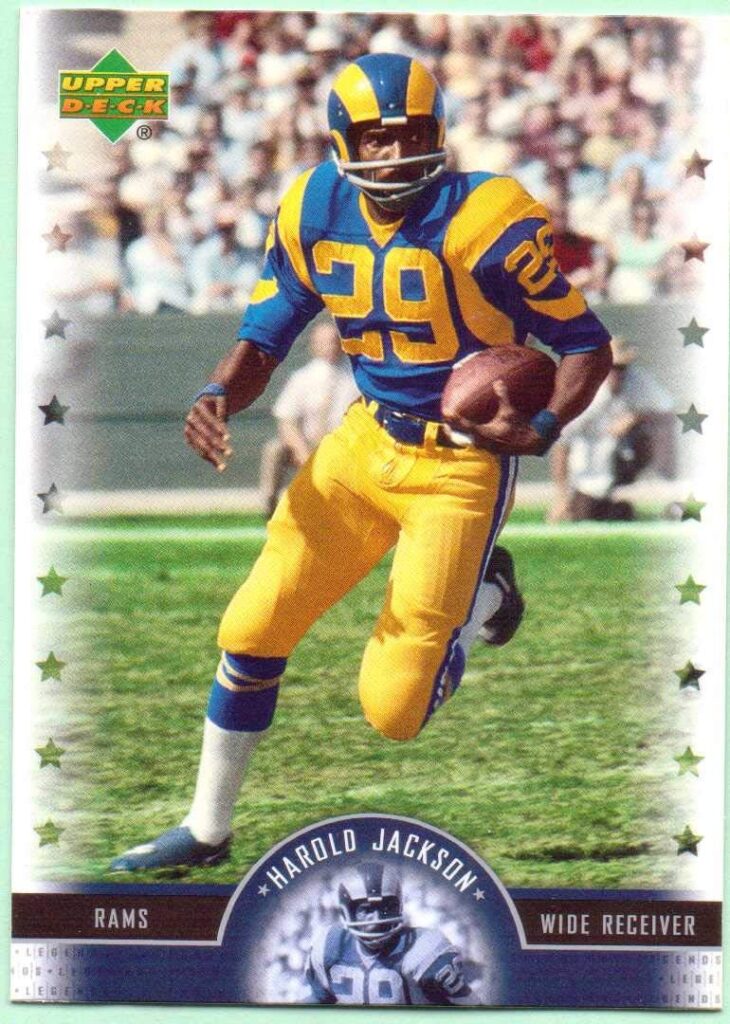

Thanks for this compelling article. I look forward to more like it in the not too distant future. Cheers again
Have you ever thought of including extra videos to your blog posts to maintain the readers extra entertained? I mean I simply read through your complete article of yours and it was fairly good but since I’m more of a visual learner,I found that to be more helpful. well, let me know how it turns out!
If you dont mind, exactly where do you host your web site? I am searching for a great host and your webpage appears to be extremely fast and up most the time
Everything is very open with a precise clarification of the
challenges. It was really informative. Your site is extremely helpful.
Many thanks for sharing!
Hi Tennis Anyone?
Thiss is a topic that is near to mmy heart… Thank you!
Exactly where are youur contact details though?
Trying to find effective online marketing that isn’t full of BS? Sorry to bug you on your contact form but actually that was kinda the point. We can send your advertising message to websites through their contact forms just like you’re getting this message right now. You can specify targets by keyword or just do bulk blasts to sites in the location of your choice. So let’s say you want to blast a message to all the mortgage brokers in the US, we’ll scrape websites for only those and post your ad message to them. Providing you’re advertising something that’s relevant to that business category then you’ll be blessed with an awesome result!
Shoot an email to [email protected] to get info and prices
Trying to find effective advertising that isn’t full of crap? Sorry to bug you on your contact form but actually that was the whole point. We can send your ad message to sites via their contact pages just like you’re getting this note right now. You can target by keyword or just go with bulk blasts to sites in any country you choose. So let’s assume you want to blast an ad to all the plumbing companies in the US, we’ll scrape websites for only those and post your ad message to them. Providing you’re advertising something that’s relevant to that niche then you’ll get awesome results!
Type up a quick note to [email protected] for the full details